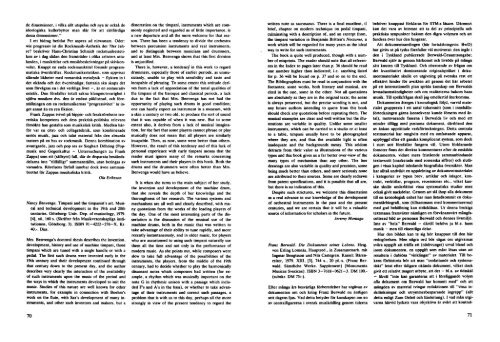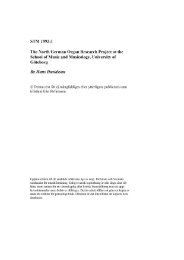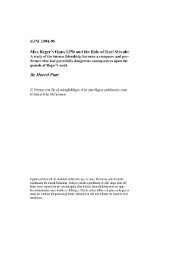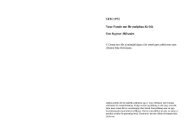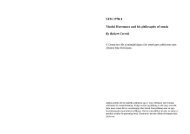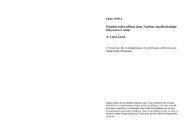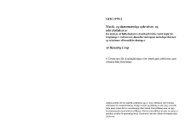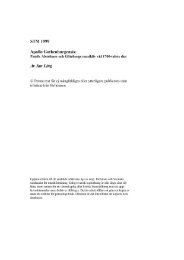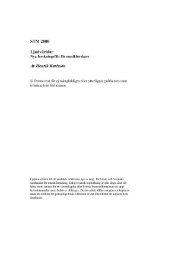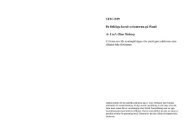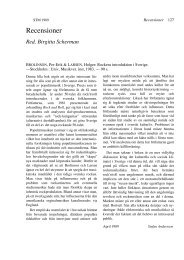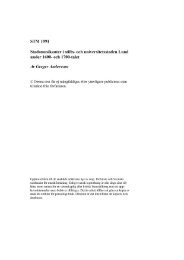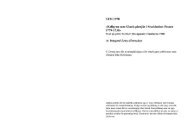Recensioner - Svenska samfundet för musikforskning
Recensioner - Svenska samfundet för musikforskning
Recensioner - Svenska samfundet för musikforskning
You also want an ePaper? Increase the reach of your titles
YUMPU automatically turns print PDFs into web optimized ePapers that Google loves.
de dimensioner, i vilka allt utspelas och nya är också de.<br />
ideologiska kullerbyttor man slår <strong>för</strong> att rättfärdiga<br />
dessa dimensioner."<br />
I ett bidrag betitlat Per aspera ad nirwanam. Oder:<br />
wie progressiv ist die Rockmusik-Ästhetik der 70er Jah-<br />
re? beskriver Hans-Christian Schmidt rockmusikesteti-<br />
ken av i dag sådan den framträder i olika artisters utta-<br />
landen, i musiktitlar och musikbeskrivningar på skivkon-<br />
volut. Knappt en enda rockmusiktitel <strong>för</strong>smår program-<br />
matiska överskrifter. Rockmusikestetiken. som uppvisar<br />
slående likheter med romantisk metafysik - flykten in i<br />
det okända och det översinnliga; fantasin ska skapa det<br />
som <strong>för</strong>vägras en i det verkliga livet -, är en restaurativ<br />
estetik. Den <strong>för</strong>efaller totalt sakna klangmotsvarighet i<br />
själva musiken dvs. den är endast påklistrad, och <strong>för</strong>e-<br />
ställningen om en rockmusikernas "progressivitet" är in-<br />
get annat än en ren fiktion.<br />
Frank Zappas tvivel på hippie- och freakrörelsens teo-<br />
retiska kompetens och dess praktisk-politiska relevans<br />
<strong>för</strong>sökte han gestalta som musikalisk kritik. Medlen här-<br />
<strong>för</strong> var en citat- och collageteknik, som kombinerade<br />
seriös musik, jazz och talat material från den absurda<br />
teatern på en bas av rockmusik. Denna kombination av<br />
avantgarde, jazz och pop ses av Sieghart Döhring (Pop-<br />
musik und Gegenkultur - Untersuchungen zu Frank<br />
Zappa) som ett (sällsynt) fall, där de disparata bestånds-<br />
delarna inte "tillfälligt" sammanställts, utan betingas av<br />
varandra. Rörelsens <strong>för</strong>fall innebar dock även samman-<br />
brottet <strong>för</strong> Zappas musikaliska kritik.<br />
Ola Eriksson<br />
Nancy Benvenga, Timpani and the timpanist's art. Musi-<br />
cal and technical development in the 19th and 20th<br />
centuries. Göteborg: Univ. Dep. of musicology. 1979.<br />
[4]. xii, 160 s. (Skrifter från Musikvetenskapliga insti-<br />
tutionen, Göteborg; 3). ISBN 91-4222-276-X. Kr.<br />
40.-. Diss.<br />
Mrs. Benvenga's doctoral thesis describes the invention,<br />
development, history and use of machine timpani, those<br />
timpani which are tuned with a single handle or with a<br />
pedal. The first such drums were invented early in the<br />
19th century and their development continued through<br />
that century down to the present day, and the author<br />
describes very clearly the interaction of the availability<br />
of such instruments upon the music of the period and<br />
the ways in which the instruments developed to suit the<br />
music. Studies of this nature are well known for other<br />
instruments, for example in connection with Boehm's<br />
work on the flute, with Sax's development of many in-<br />
struments. and other such inventors and makers, but a<br />
dissertation on the timpani. instruments which are com-<br />
monly neglected and regarded as of little importance, is<br />
a new departure and all the more welcome for that rea-<br />
son. There has been a tendency to divide the orchestra<br />
between percussion instruments and real instruments,<br />
and to distinguish between musicians and drummers,<br />
and at least Mrs. Benvenga shows that this first division<br />
is unjustified.<br />
There is. however, a tendency in this work to regard<br />
drummers, especially those of earlier periods, as<br />
unmusicianly. unable to play with sensibility and taste and<br />
incapable of phrasing. To some extent this attitude deri-<br />
ves from a lack of appreciation of the tonal qualities of<br />
the timpani of the baroque and classical periods, a lack<br />
due to the fact that Mrs. Benvenga has not had the<br />
opportunity of playing such drums in good condition;<br />
one can hardly expect an instrument in a museum, with<br />
a skin a century or two old, to produce the sort of sound<br />
that it was capable of when it was new. But to some<br />
extent also, it derives from a lack of musical imagina-<br />
tion, for the fact that some players cannot phrase or play<br />
musically does not mean that all players are similarly<br />
incapable. Then, as now, some were better than others.<br />
However, the result of this tendency and of this lack of<br />
personal experience with early timpani means that the<br />
reader must ignore many of the remarks concerning<br />
such instruments and their players in this book. Both the<br />
drums and the drummers were often better than Mrs.<br />
Benvenga would have us believe.<br />
It is when she tums to the main subject of her study,<br />
the invention and development of the machine drum,<br />
that she reveals the depth of her knowledge and the<br />
thoroughness of her research. The various systems and<br />
mechanisms are all well and clearly described, with ma-<br />
ny quotations from the works of the leading players of<br />
the day. One of the most interesting parts of the dis-<br />
sertation is the discussion of the musical use of the<br />
machine drums, both in the music that was written to<br />
take advantage of their ability to tune rapidly, and more<br />
recently instantaneously. and in older music, for players<br />
who are accustomed to using such timpani naturally use<br />
them all the time and not only in the performance of<br />
modem music. As she points out, while composers were<br />
slow to take full advantage of the possibilities of the<br />
instruments, the players, from the middle of the 19th<br />
century. had to decide whether to play the harmonically<br />
dissonant notes which composers had written (for ex-<br />
ample, a rhythm which was musically important on the<br />
note G in rhythmic unison with a passage which inclu-<br />
ded F's and A's in the bass), or whether to take advan-<br />
tage of their instruments and correct such passages, a<br />
problem that is with us to this day, perhaps all the more<br />
strongly in view of the present tendency to regard the<br />
written note as sacrosanct. There is a final excellent, if<br />
brief, chapter on modern technique on pedal timpani,<br />
culminating with a description of, and an excerpt from,<br />
the timpani variation in Benjamin Britten's Nocturne, a<br />
work which will be regarded for many years as the ideal<br />
way to write for such instruments.<br />
The book is quite well produced, though with a num-<br />
ber of misprints. The reader should note that all referen-<br />
ces in the Index to pages later than p. 36 should be read<br />
one number higher than indicated; i.e. anything listed<br />
for p. 36 will be found on p. 37 and so on to the end.<br />
The Bibliographies must be read in conjunction with the<br />
footnotes; some works, both literary and musical, are<br />
cited in the one, some in the other. Not all quotations<br />
are absolutely as they are in the original texts; the sense<br />
is always preserved, but the precise wording is not, and<br />
any future authors intending to quote from this book<br />
should check any quotations before repeating them. The<br />
musical examples are clear and well written but the illu-<br />
strations are variable in quality. Unlike some smaller<br />
instruments, which can be carried to a studio or at least<br />
to a table, timpani usually have to be photographed<br />
where they are, and thus the available light is often<br />
inadequate and the backgrounds messy. This seldom<br />
detracts from their value as illustrations of the various<br />
types and this book gives us a far better over-view of the<br />
many types of mechanism than any other. The line<br />
drawings are also variable in quality and precision. 'some<br />
being much better than others, and more seriously none<br />
are attributed to their sources. Some are clearly redrawn<br />
from patent specifications, and it is possible that all are,<br />
but there is no indication of this.<br />
Despite such strictures, we welcome this dissertation<br />
as a real advance in our knowledge of the development<br />
of orchestral instruments in the past and the present<br />
centuries. and we are certain that it will be a valuable<br />
source of information for scholars in the future.<br />
Jeremy Montagu<br />
Franz Bewald. Die Dokumente seines Lebens. Hrsg.<br />
von Erling Lomnäs, Hauptred., in Zusammenarb. mit<br />
Ingmar Bengtsson und Nils Castegren. Kassel: Bären-<br />
reiter, 1979. XIII, [3], 744 s., 20 pl.-s. (Franz Ber-<br />
wald. Sämtliche Werke. Supplement) (Monumenta<br />
Musicae Svecicae). ISBN 3-7618-0621-3. DM 100.-<br />
(subskr. DM 75:-).<br />
Efter många års besvärliga <strong>för</strong>beredelser har utgåvan av<br />
dokumenten om och kring Franz Berwald nu äntligen<br />
sett dagens ljus. Vad detta betyder <strong>för</strong> kunskapen om en<br />
av centralfigurerna i svensk musikodling genom tiderna<br />
behöver knappast <strong>för</strong>klaras <strong>för</strong> STM:s läsare. Däremot<br />
kan det vara av intresse att ta del av principiella och<br />
praktiska synpunkter bakom den digra volymen och att<br />
fundera över hur den fungerar.<br />
Att dokumentsamlingen (här fortsättningsvis: BwD)<br />
har givits ut på tyska <strong>för</strong>efaller väl motiverat: den ingår i<br />
den i Tyskland publicerade Bewald-Gesamtausgabe;<br />
Berwald själv är genom härkomst och livsöde på många<br />
sätt knuten till Tyskland. Och oberoende av frågan om<br />
det kvantitativt dominerande originalspråket i doku-<br />
mentmaterialet skulle en utgivning på svenska rest ett<br />
effektivt hinder <strong>för</strong> avsikten att genom det här arbetet<br />
på ett internationellt plan sprida kunskap om Berwalds<br />
levnadsomständigheter och om realiteterna bakom hans<br />
musik. Til språkfrågan skall jag emellertid återkomma.<br />
Dokumenten återges i kronologisk följd, varvid mate-<br />
rialet grupperats i ett antal tidsavsnitt (som i innehålls-<br />
<strong>för</strong>teckningen gärna konsekvent kunde <strong>för</strong>setts med år<br />
tal), motsvarande faserna i Berwalds liv och med ett<br />
mindre tillägg med postuma dokument, däribland den<br />
av änkan upprättade verk<strong>för</strong>teckningen. Detta centrala<br />
textmaterial har omgivits med en omfattande apparat,<br />
uppbyggd efter ett ganska komplicerat system, som dock<br />
i stort sett <strong>för</strong>efaller fungera väl. Utom <strong>för</strong>klarande<br />
fotnoter finns det direkta kommentarer efter de enskilda<br />
dokumenten, vidare mera fristående sammanbindande<br />
textavsnitt (markerade med romerska siffror) och slutli-<br />
gen i vissa kapitel inledande biografiska översikter. Man<br />
har alltså undvikit en uppdelning av dokumentmaterialet<br />
i kategorier av typen brev, artiklar och inlagor, kon-<br />
trakt, verktitlar. program, recensioner etc., vilket kan-<br />
ske skulle underlättat vissa systematiska studier men<br />
ockå givit nackdelar. Genom att slå ihop alla dokument<br />
till en kronologisk enhet har man åstadkommit en doku-<br />
mentärbiografi, som (tillsammans med kommentarerna)<br />
med god behållning kan sträckläsas. Ur denna brokiga<br />
textmassa framväxer nämligen en <strong>för</strong>vånansvärt<br />
mångfaceterad bild av personen Berwald och dennes livsmiljö.<br />
Inte av "hela" Berwald - därtill behövs ju bl.a. hans<br />
musik - men till väsentliga delar.<br />
Hur den bilden kan te sig hör knappast till den här<br />
redogörelsen. Men några ord bör sägas om utgivarnas<br />
svåra uppgift att träffa ett (nödtvunget) urval bland och<br />
inom dokumenten, en uppgift som måst lösas utan att<br />
resultera i dubiösa "vinklingar" av materialet. Till bo-<br />
kens <strong>för</strong>historia hör att man "Omfattande och systema-<br />
tiskt" letat efter tidigare okända dokument, vilket dock<br />
givit ett relativt magert utbyte, att det - bl.a. av tidsskäl<br />
- likväl "inte kan garanteras att i <strong>för</strong>eliggande volym<br />
alla dokument om Berwald har kommit med" och att<br />
mängden av material tvingat redaktionen till "vissa in-<br />
skränkningar och utrymmesbesparande ingrepp'' (allt<br />
detta enligt Zum Geleit och Einleitung). I vad mån utgi-<br />
varna härvid lyckats vara objektiva är svårt att kontrol-


